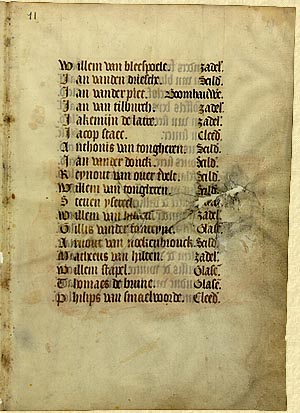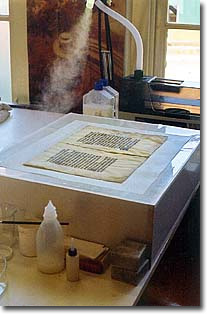This archived website 'Flemish primitives' is temporarily not being updated. Certain functionality (e.g. specific searches in the collection) may no longer be available. News updates about the Flemish primitives will appear on vlaamsekunstcollectie.be. Questions about this website? Please contact us at info@vlaamsekunstcollectie.be.
The memorial list of Bruges painters

Historians and art historians have been aware of the importance of the memorial list of Bruges picture makers for a long time. Both in the 19th and 20th centuries, the text had been published already. At the great Memling exhibition in 1994 the document was put on display for the last time. The memorial list of the Bruges picture makers' and saddlers' trade is an archival, i.e. official document. The memorial list served for one of the activities within the trade, which is the commemoration of all deceased members during an official service. There are two indications of the fact that we are really dealing with a document of the trade archives: first of all, it always carefully registered which subdivision of the trade the deceased had belonged to (painters, saddlers, canvas painters, saddlebow makers, harness makers, stained-glass artists and mirror makers); subsequently, some members are indicated as deacons: it always concerns the deacons of the trade. It is clear that this document is most valuable for the study of the history of painting in Bruges.

The register contains the names of all free masters of the trade who died as members of the trade between 1450 and 1801. The year of death was not mentioned until the beginning of the 17th century. Before that, the year of death was sometimes added by another hand. For instance, in Gerard David's case, on p. 27, the (erroneous) year of death 1524 was added. In actual fact, Gerard David died in 1523. Yet the register contains a number of major objective data: the name of the deceased together with his profession are proof of his membership at the time he died; every registered name also produces evidence of one person's existence, which may be important to distinguish between various people bearing the same name; and obviously, the (non) occurrence of a name is an indication of his death in Bruges. All things considered the register contains data about 354 painters, 88 saddlers, four saddlebow makers, 120 canvas painters, 194 stained-glass artists, 85 harness makers, 26 mirror makers, four gold foil illuminators, two incunable printers and a dozen others.
So the present memorial list was copied around 1490 from an older memorial list, which was started in 1450. This older memorial list was obviously not kept up to date and it was replaced in the eighties of the 15th century. It was not damaged until World War II, just a few weeks before the Liberation in September 1944. In 1942, the City Council had considered it advisable for security's sake to remove the most precious pieces of the City Archives, the Groeninge Museum, the City Library and the social welfare council and to store them in the uninhabited but well-maintained castle of Lavaux-Sainte-Anne (presently the City of Rochefort in the province of Namur). On 16 August 1944, the Bruges City Council decided that the cases and boxes of the City Archives of Bruges, together with the remaining masterpieces and precious works of the City Library, had to be taken to Brussels. A first convoy left on 22 August 1944. Subsequently, the second convoy left on 26 August. This second convoy was inadvertently fired upon by the allied air force in Bouvignes (currently the Cityity of Dinant) shortly after it had left. Five trucks were riddled with bullets. During the firing, two guides were killed, there were five serious casualties and various people were slightly wounded. Several records had obviously suffered damage as well. Ever since, quite some documents of the City Archives have had bullet holes.

The memorial list of the Bruges painters' trade had suffered an awful lot of damage. A bullet had penetrated the register from the back side and got stuck against the inner side of the front board. The wooden boards were shattered and parts are missing. The parchment leaves all have a bullet hole in the text section. Around this hole there were many long irregular star-shaped tears.
The Bruges archive records were moved to Brussels after this unfortunate incident. They remained in the cellars of the National Bank until 17 May 1945, more than eight months after the Liberation of Bruges and more than a week after the official war end.
The damaged Bruges archive documents were hardly repaired after their return in 1945. The shattered binding of the memorial list remained untouched, so afterwards parts of the back and the boards got lost for sure. In April 2000, restoration of the memorial list was commenced. It was finished in August 2001. The restoration was based on the preservation of the remaining historical information. New material was added as little as possible and is very recognisable, tested in advance and of the highest quality.
Evidently, the memorial list cannot simply be placed at the visitors' disposal in the reading room. Anyway, it was not possible to consult the memorial list in the reading room before the restoration either: its physical condition did not allow this. In the 21st century, a new disclosure has been chosen: the memorial list on the internet.
A thorough examination of the memorial list of Bruges painters can be found on this website, an initiative of www.historischebronnenbrugge.be. This is a digital publishing platform for important historic sources concerning Bruges.
The Memorial list of Bruges painters is preserved at the City Archives of Bruges, Oud Archief, serial no. 314: Beeldenmakers. The transcription 2001 was carried out by Noël Geirnaert and Marcella Vandebroek (Municipal Archives of Bruges), based on the original and the edition of Charles Vanden Haute (1913). Photographs: Marijn de Valk, restorer, and Dirk Van der Borght, photographer of the city of Bruges.






